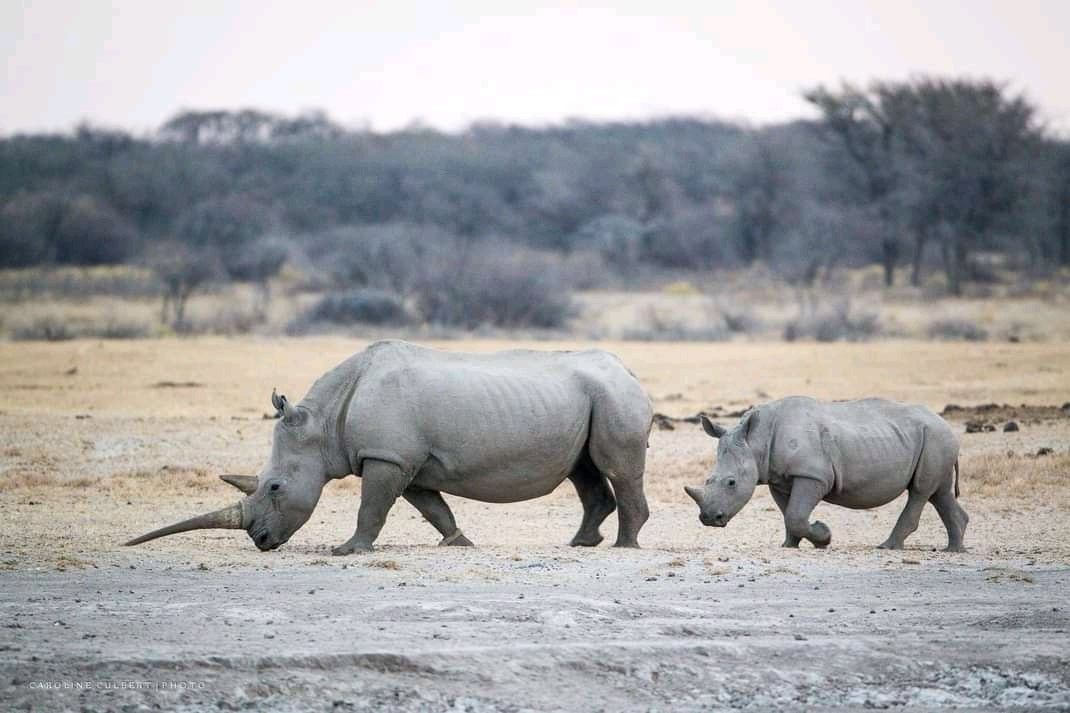Sisboy, the orphaned rhino, is safe and sound at Khama Rhino Sanctuary
Poaching has skyrocketed in other parts of Botswana, but KRS remains a safe haven for rhino and other species

By Boniface Keakabetse for The Okavango Express
Black rhinoceros calf, ‘Sisboy’, named after Botswana President Mokgweetsi Masisi, was just 26 months old when his mother was killed by poachers in the Okavango Delta.
Rhino poaching in Botswana’s Okavango Delta has worsened since 2019 with reports of almost a hundred rhinos having been killed by poachers despite the Government dismissing the figure.
It is understood that the Delta had a total of 300 rhinos, with the poaching increase forcing the Government to translocate the remaining rhinos to a safer, guarded facility. Sisboy’s mother was gunned down by poachers in September 2019 in the Mombo concession, viewed as one of the safest parts of Okavango Delta at the time. The two foreign poachers involved were shot dead by Botswana Defence Force’s anti-poaching team.
The Department of Wildlife and National Parks (DWNP) were forced to pull Sisboy away from its mother’s carcass where he had stayed, waiting for her to wake up. DWNP feared that if left in the bush, the calf was going to remain by his mother’s carcass until he died, so officers relocated him to Khama Rhino Sanctuary (KRS) for safety.
An online story of the orphan led to many readers pouring their grief for him. Some comments at the time suggested that the young rhino must be sent to KRS, while others suggested he must be given a name.
The author of the story, environmental journalist Boniface Keakabetse suggested the revered nickname of President Masisi: ‘Sisboy’ for the orphan. The journalist hoped that this presidential nickname would serve as a reminder to Botswana, and the Government, about the impending danger posed by poaching, to Botswana’s wildlife and the affiliated tourism sector.
Following the sad demise of his mother in the Delta, Sisboy, as he is now affectionately called by wardens and guides at KRS, has found a safe refuge.
KRS has not recorded a single case of rhino poaching since its establishment in 1992. The oldest rhino at the refuge is a 42 year old white rhino cow named ‘Curved Horn’, who was brought to the sanctuary from South Africa in 1980.
‘’Sisboy was very depressed when he got here. He kept away from other rhinos and mainly wanted to be closer to humans all the time,’’ Thapelo Baipheti, Chief Warden of KRS, recalled. Baipheti was briefing Botswana media participants of the African Conservation Journalism Programme, funded by USAID’s VukaNow activity and implemented by Space for Giants, during their tour of KRS recently. He told the Botswana media contingent that KRS is a community- based project setup in 1992 to assist in saving the diminishing Botswana rhino population at the time.
KRS is tucked away on a piece of land covering approximately, 8585 hectares of Kalahari Sandveld. Baipheti added that the sanctuary provides refuge and habitat for white and black rhino as well as over 30 other animal species and more than 230 species of birds.
Botswana Defence Force (BDF) provides security at the sanctuary and so far not a single poaching incident has been recorded in the area.
Baipheti opined that the security offered by BDF and vigilance of stakeholders at all times are key to protecting the sanctuary in the wake of unprecedented rhino poaching experienced in the Okavango Delta. He stated that KRS location in the central region of Botswana, compared to the vast and swampy Okavango Delta’s location bordering Namibia, has comparatively ensured KRS’s safety.
The Chief Warden said KRS annually spends P 200,000 (around GBP 12,000) on community projects in the nearby Serowe, Mabeleapudi and Paje villages. The villagers identify the projects they want to be sponsored by KRS.
Duncan Boikhutso, a guide at KRS added: ‘’The community benefits help us ensure that the neighbouring communities support our efforts at saving these mega species. When the people derive the benefits they see the need to conserve and help to prevent poaching.’’
Chief for Mabeleapudi Village, Sebonego Tebelelo, who also met the media crew, revealed that KRS donated funds for construction of a shelter for Kgotla (community meeting centre), procured air conditioners for community offices and helped with funds for various community celebrations. However, Chief Sebonego added that they have not received support from KRS since the global coronavirus pandemic began in 2020, as it impacted tourism, including visitation to the sanctuary.
This article is reproduced here as part of the African Conservation Journalism Programme, funded in Angola, Botswana, Mozambique, and Zimbabwe by USAID’s VukaNow: Activity. Implemented by the international conservation organization Space for Giants, it aims to expand the reach of conservation and environmental journalism in Africa, and bring more African voices into the international conservation debate. Read the original story here.
Join our commenting forum
Join thought-provoking conversations, follow other Independent readers and see their replies
Comments
Bookmark popover
Removed from bookmarks